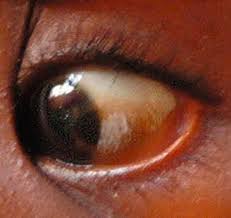 Xerophthalmia is ocular manifestations resulting from vitamin A deficiency, characterized by conjunctival and corneal dryness, Bitot’s spots, keratomalacia, and, in severe cases, corneal ulceration and blindness.
Xerophthalmia is ocular manifestations resulting from vitamin A deficiency, characterized by conjunctival and corneal dryness, Bitot’s spots, keratomalacia, and, in severe cases, corneal ulceration and blindness.
It is a major cause of preventable blindness, particularly in children in developing countries, but can also occur in individuals with malabsorption or dietary insufficiency in developed settings.
There is a relationship between xerophthalmia and the function of rhodopsin in the retina.
Rhodopsin, the photopigment in rod cells, requires 11-cis-retinal, a derivative of vitamin A, as its chromophore.
Vitamin A deficiency impairs the synthesis of 11-cis-retinal, leading to defective rhodopsin regeneration.
This results in impaired rod function and manifests clinically as nyctalopia (night blindness), which is often the earliest symptom of xerophthalmia.
Persistent deficiency leads to progressive structural and functional damage to the ocular surface and retina, culminating in the full clinical spectrum of xerophthalmia.
Prompt recognition and vitamin A supplementation can reverse early manifestations and prevent progression to irreversible blindness.
